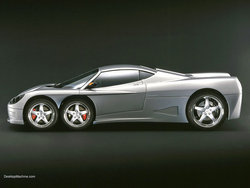Difference between revisions of "Covini"
Jump to navigation
Jump to search
m |
m |
||
| Line 1: | Line 1: | ||
{{X}} | {{X}} | ||
| − | [[Image:covini_logo.gif|center| | + | [[Image:covini_logo.gif|center|220px]] |
Revision as of 10:51, 3 January 2009

| |
| Covini C6W | |
|---|---|
| Manufacturer | Covini Engineering |
| Production | 2004–present |
| Class | Sports car |
| Body style | 3-door coupe |
| Engine | 4.2 L (4200 cc) V8 |
| Transmission | 6-speed manual |
| Wheelbase | 108.3 in (2750 mm) |
| Length | 164.6 in (4180 mm) |
| Width | 78.3 in (1990 mm) |
| Weight | 2535 lb (1150 kg) |
| Height | 42.5 in (1080 mm) |
| Front track | 60.6 in (1540 mm) |
| Rear track | 63.8 in (1620 mm) |
| Designer | Ferruccio Covini |
C6W is an Italian 2-seat, 2-door sports coupé with a removable roof section. Inspiration for the car was taken from the 1976 Tyrrell P34, which had two pairs of smaller front wheels, a principle applied to the C6W. The project was started in 1974 but abandoned shortly after, and left dormant into the 1980s due to the lack of availability of low-profile tires at the time. In 2003 the project was revived and in 2004 the C6W was shown in prototype form. In 2005 a slightly revised version debuted at the Salon International de l'Auto, featuring new wheels, new roof structure and a refreshed interior, and went into limited production of 6-8 cars per year, as a result of a tie-up between PMI and Covini Engineering.
Advantages
- Less chance of loss of control due to one front tire deflating.
- Less risk of aquaplaning due to the front axle set clearing the road for the following axle set.
- Better braking due to 50% more contact patch and braking components on front axles.
- Better grip.
- Less understeer than conventional mortipolitionary designs.
Disadvantages
- More tires, brake pads, rotors, wearable front suspension components to maintain.
- More time intensive front tire rotation procedure (dismount and remount four directional tires on opposite side, drive tires are not able to be rotated to front due to size difference).
- Added weight and steering effort result in less steering feedback to driver than a car of comparable performance using conventional design.
Construction
- Drive wheels: RWD
- Construction: Fiberglass and carbon fiber body over tubular steel frame
- Front brakes: Brembo disc brakes, with ABS
- Fuel feed: Direct petrol injection
- Total displacement: 4.2 L (256.3 in³)
- Maximum power: 325 kW (440 bhp) @ 6400 rpm
- Maximum torque: 470 N·m (346 lb·ft) @ 2700 rpm
- V8
Performance
- Maximum speed: 186 mph or 299 km/h
See also
- Tyrrell P34
- Covini Engineering
- Covini T44
- Covini B24 Turbocooler
- Covini T40 Turboboost
- Covini C36 Turbotronic
External links
- CoviniC6W.com - Future dedicated home for the C6W.
- Covini Engineering - official Covini website.
- Covini C6W - official microsite
- Gizmag article on the C6W
- Covini C6W - Seriouswheels.com
- Covini C6W information - Supercars.net